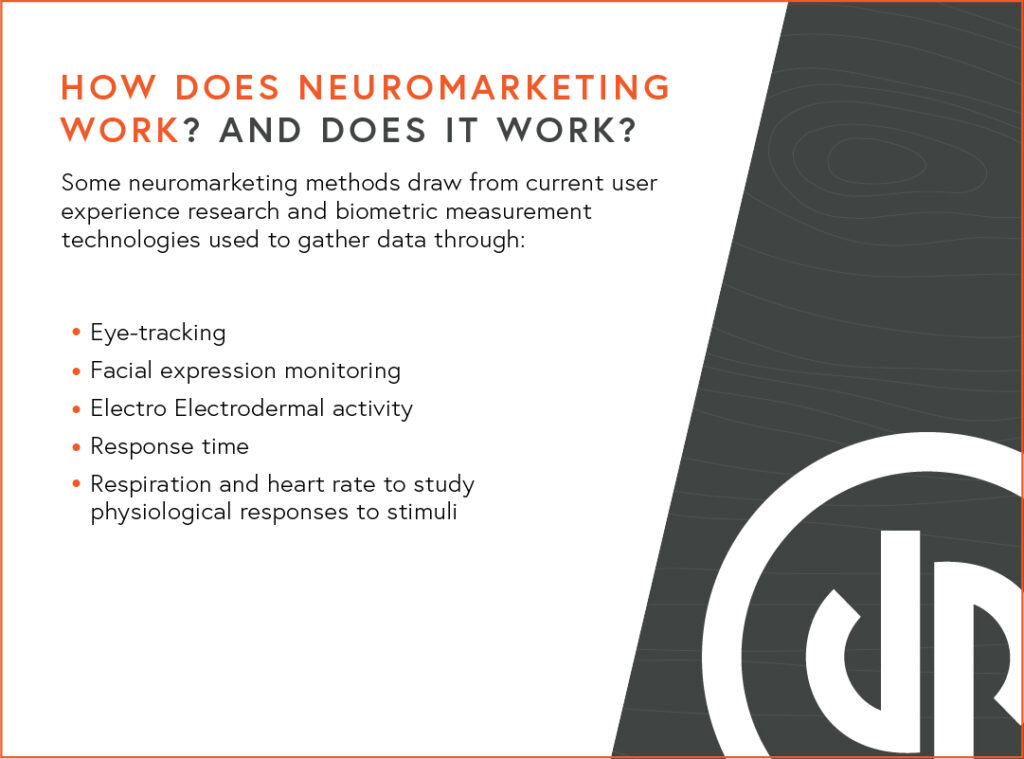Neuromarketing uses neuroscience to reveal subconscious consumer decision-making processes. Neuromarketers study brain- and biometric responses and behavior to understand and shape how consumers feel, think, and act.
Essentially, neuromarketing is designing your content, website, etc., eliciting particular neurological reactions associated with buying or emotions linked to buying.
By using neuromarketing, you can rethink your strategies and create smarter marketing that will boost the effectiveness of your efforts. The goal is to understand how your customer’s brain works and what effects your marketing will have on the population of consumers.

How does neuromarketing work? And does it work?
Some neuromarketing methods draw from current user experience research and biometric measurement technologies used to gather data through:
- Eye-tracking
- Facial expression monitoring
- Electro Electrodermal activity
- Response time
- Respiration and heart rate to study physiological responses to stimuli

The contributions of neuroscience technologies such as electroencephalography (EEG), functional magnetic resonance imaging (fMRI), and magnetoencephalography (MEG) that monitor neural responses can show participant reactions that may remain unconscious.
Understanding the positive or negative reactions to sensory stimuli such as colors, sounds, and other qualities can help marketers and product designers adjust design and messaging to impact customers more effectively.
Brands such as Campbell’s Soup, Gerber, and Frito-Lay have used neuromarketing to restyle their packaging designs. In these instances, consumers were exposed to a product’s packaging piece by piece, and their response was recorded as positive, neutral, or negative. This information was then used with an in-depth interview to analyze specific points that eventually resulted in changes to elements such as color, text size, and imagery.
· Frito-Lay, for instance, discovered matte bags with pictures of potatoes did not trigger a negative response, whereas shiny bags with pictures of chips on them did. Within months, new bags were designed, and the shiny ones were scrapped.
· In another case, Hyundai utilized neuromarketing when they gave thirty participants EEG caps and asked them to examine a car prototype for an hour.
· Last but not least, PayPal discovered that commercials focusing on speed and convenience triggered a significantly higher response than those advertising safety and security and developed an entirely new ad campaign based on the results.
Neuromarketing has not yet fully matured, but it has come a long way in just a few years. Another five to ten years could make all the difference. The prohibitive cost will come down as technology improves and firms compete. Results and actionable insights will grow more reliable, valuable, and attainable.
Some dismiss neuromarketing as useless because they see it as merely confirming what traditional marketing research already knows. Writing it off may be fair if the field is supposed to be fully mature. But neuromarketing is just now coming into its own.
Neuroscience and the technologies available to neuroscience and marketing continue to develop. This makes the confirmation of existing knowledge look like confirmation of the potential for more developed and mature neuromarketing.

This blog post was written by Natalie Rodríguez, Data Advisor at DuartePino.

